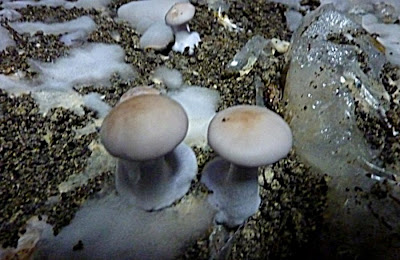Mushroom-growing became a huge operation. More than 50 people were employed at the Cave des Roches alone in its heyday, and there were several other mushroom cellars as well. A big mushroom-canning plant was built nearby. The mushrooms grown and processed in Bourré were the ones called « champignons de Paris » in French — "button mushrooms" is what we call them. They were first grown commercially in the underground network of tunnels left by quarrying in the Paris area — hence the name.
In the mid-20th century, the Cave des Roches produced more mushrooms in a day than it now produces in a month, the tour guide told us. There are currently only six employees. The mushroom business in the Loire Valley is now a specialized activity catering to a small, upscale market, and of course a tourist attraction. The relatively small Bourré mushroom harvest goes not to large-scale canning operations and retail sales, but to high-end restaurants and gourmet chefs.
What happened to cause such a decline in Loire Valley mushroom production? New cultivation methods across Europe — hydroponic methods in vast greenhouses — changed everything. Quality declined too, overall, the Cave des Roches people say. Mushrooms grown hydroponically under artificial conditions in gigantic greenhouses are clean, white, and pretty, but bland and textureless, compared to mushrooms grown according to traditional methods in the natural environment of old-style cellars.
The Cave des Roches has survived by diversifying and going upscale. Instead of growing tons of button mushrooms, nowadays they grow shiitakes, gray and yellow oyster mushrooms, and a variety called the blue-foot — le pied-bleu. Restaurant chefs want the unusual and the exotic. Those mushrooms cost two, three, or four times to grow as do standard champignons de Paris, and the sales prices reflect that.
Les cueilleuses — the gatherers or pickers — work their way through the mushroom galleries several times a day, harvesting the mushrooms that are ready for market. The button mushrooms grown here are brown, not white, ones, and have a lot more flavor and texture than the pure white ones you get at the supermarket. The temperature in the old quarry tunnels is a constant 13ºC, or about 55ºF, year-round.
 Brown button mushrooms (champignons de Paris)
Brown button mushrooms (champignons de Paris)grow in pasteurized horse manure in the Bourré cellars.
Button mushrooms are grown in beds of pasteurized, composted horse manure. Blue-foot mushrooms grow in beds of vegetable-matter compost, and La Cave des Roches produces 40% of the world blue-foot crop. Shiitakes are grown in still another specialized compost mixture. Each growing medium is pasteurized or sterilized, so that other mushrooms and bacteria don't contaminate the crop, and then injected with pure mushrooms spores produced in laboratories under controlled conditions.
 A cluster of yellow oyster mushrooms (pleurottes jaunes)
A cluster of yellow oyster mushrooms (pleurottes jaunes)emerges from hole poked in a plastic bag full of compost.
Oyster mushroom are grown in spore-injected compost contained in black plastic leaf bags. Holes are punched in the bag and a cluster of mushrooms grows out of each hole. When the clusters are ready to pick, the gatherers poke another hole in the bag, at a different spot, and a new cluster emerges. If left to their own devices, all the oyster mushrooms would grow and "ripen" at the same time, and they couldn't be harvested over a period of weeks. The hole-in-the-bag method produces a series of crops at a regular rhythm.
At the Cave des Roches, there's a boutique where you can by both fresh and processed mushrooms of all the varieties grown in the cellars. The processed ones are sold in tins and in jars. As Walt said in his post yesterday, the tour guides speak both French and English. The tour takes about an hour. Bring a fleece jacket or a sweatshirt with you when you come, even if it is hot outdoors.







I hope you got to try an oyster mushroom;) I've throughly enjoyed learning how mushrooms are grown. Thanks for that.
ReplyDeleteNow, I need to taste a blue foot one and some of the others also.
Fascinating!
ReplyDeleteI don't think I ever had a blue foot. I love mushrooms; thank you for the tour.
ReplyDeleteIts a romantic life styleliving in Paris.. Beautiful snaps..!!! MOVING TO PARIS
ReplyDeleteVery interesting!
ReplyDeleteI've never even heard of blue-foot mushrooms. Have you ever seen them used anywhere?
ReplyDeleteWent on a tour. The guide did not speak any English
ReplyDelete